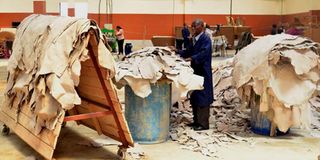Yes, a ban on mitumba is good for livestock keepers

Workers at Reddamac Leather Centre along Eastern bypass in Nairobi in 2015. The business processes hides and skins for export and into finished leather products.
To ban or not to ban second-hand clothes from the Kenyan market has become a campaign issue for next month’s elections. I was, therefore, not surprised when a farmer asked me whether I thought banning of the clothes would be of any value to Kenyan livestock farmers.
Being interested in leadership matters, I patiently listened to the farmer as she narrated the benefits of second-hand clothes. I, however, noted she was not wearing a second-hand. I also never saw any second-hand piece of clothing on her drying lines nearby.
My observation on her choice of clothing prompted me to ask her why she never wore the clothes she was advocating. She quickly responded new quality clothes were affordable to her. She concluded by asking what her workers would wear if the second-hand clothes were banned.
The farmer further said if the clothes were banned, her workers might not find it worth working for her because they may end up spending too much money on new clothes, but she may not be able to increase their salaries to match the new demand.
This confirmed to me that when our leaders make public pronouncements on matters that are not well-thought out; they never know the socio-economic anguish they cause many people.
For the majority of Kenyans, the thought of banning second-hand clothes only illuminates the challenges many would have buying new clothes. Most people only focus on revitalising the cotton industry, but the issue is much wider than that.
I engaged the farmer on discussions on the textile industry. She needed to know that her livestock farming is part of the textile industry. You see, the textile industry is not a standalone economic activity. It is an ecology of industries. It is like a forest full of many species of life, both animals and plants that live dependently on each other.
Second-hand clothes
For a nation like Kenya to operate primarily on the second-hand clothes industry, it is like clearing a forest and surviving only on scant vegetation. There would definitely be climate change and distress on food resources. Consequently, relying primarily on the second-hand clothes has a ripple effect on the ecology of industries that interact economically with the textile industry.
I first explained to the farmer that the textile industry is not only about crops, mainly cotton. It is also about many textile raw materials such as skin and hides, horn, hoof, bone, wool and hair from livestock. Skin and hides are generally called leather once they have been processed.
Leather products are very expensive and prestigious to wear. Last week, I wanted to buy a leather jacket. A quick survey in the Nairobi central business district showed that I could get a new quality one at between Sh5,000 and Sh60,000 all from Turkey or Italy. Yet, in Kenya, we export raw hides and skins and import the finished products mainly shoes, belts, bags and leather clothes.
It is well-established that value addition in the agricultural sector is the key to profitable agriculture directly and indirectly. In the case of livestock for instance, processed leather and leather products would fetch much higher revenues than raw hides and skins. More people would also find leather goods such as shoes, belts and clothing more affordable if made in Kenya in large volumes.
The increase in purchase and usage of leather products locally coupled with exports would raise the earnings from livestock and consequently make animal farming more profitable. That in turn would enable the livestock farmer to pay their employees better.
The industries that thrive around the new clothes sector, generally called the textile industry, are many. Interestingly, they all employ numerous people because they are labour- intensive.
First there are the professionals, like me, who advice on agriculture and manufacturing. We are followed by farmers and farm workers who produce the animals and crops.
Textile industry
Livestock of great importance to the textile industry are cattle, sheep, goats, camels, rabbits and crocodiles.
The transport industry is a major beneficiary because successful agribusiness requires a lot of movement for people, inputs, produce, products and waste. Produce refers to farm harvest while products are processed materials.
Processing is a key industry. For textiles, it involves processing of fibres like cotton, wool and hair into threads.
This involves sorting, cleaning, dying and yarning. There is also the processing of hides and skins into leather and hooves and horn into the gel used for making items like buttons.
Another industry is manufacturing where the textile rolls are made ready for the making of clothes. Finally, there are clothes and fashion design and production. Distribution of textiles is important but would never be affected by a ban on second-hand clothes.
A well-planned ban would transition the traders of second-hand clothes into trading in the new clothes at all levels of the value chain.
The main caution in banning second-hand clothes is that the transformation must be phased to correspond to the time required to educate both the traders and consumers on the benefits of the change and to give sufficient time for setting up the production, processing and manufacturing facilities for new clothes starting from farming to manufacturing. In my view, such a transformation would take 3-5 years to achieve.





